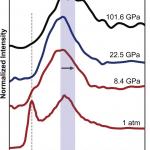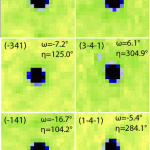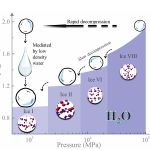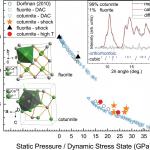Jarosite, KFe3(OH)6(SO4)2, contains perfect 2D kagomé lattices of Fe3+ ions. The geometry of the kagomé lattice engenders magnetic frustration in antiferromagnets, yet jarosite still orders magnetically at 65 K. Given that magnetic frustration can cause exotic emergent phenomena, the magnetism in jarosite has been extensively studied at ambient pressure. Previously, rigorous synthetic magnetostructural substitutional studies varied the interlayer spacing between the kagomé layers. These studies revealed that there is no trend in the Néel temperature in the iron jarosites as a function of… more
When compressed above megabar pressures (>100 GPa), glasses may undergo structural transitions into more densely packed networks that differ from those at ambient pressure. Inelastic x-ray scattering (IXS, or X-ray Raman scattering), which can probe core electron excitation from glasses in a diamond anvil cell (DAC), has enabled exploration of the pressure-induced changes in atomic configurations of elements in oxide glasses under extreme compression. While IXS provides a rare opportunity to probe the pressure-induced bonding transitions, a decade of efforts to collect an IXS signal… more
Recent discoveries of several stable dense hydrous minerals at high pressure–temperature conditions have led to an important implication of a massive water reservoir in the Earth’s lower mantle. A research team used HPCAT facility and demonstrated that (Fe,Al)OOH can be stabilized in a hexagonal lattice at 107–136 GPa and 2,400 K. By combining powder X-ray-diffraction techniques with multigrain indexation, the team has determined this hexagonal hydrous phase with a = 10.5803(6) Å and c = 2.5897(3) Å at 110 GPa, which is stable under the deep lower mantle conditions and can transform to the… more
Topological Kondo insulator possesses characteristics of both the strong electron correlations and the topological configurations, as shown in a mixed-valence material SmB6. YbB6 is a structural analog of SmB6, but remains controversial whether compressed YbB6 material is a topological insulator or a Kondo topological insulator. A research team used HPCAT facility and performed x-ray measurements on YbB6samples. Both the high-pressure powder x-ray diffraction and optical Raman measurements show no trace of structural phase… more
By engineering molecules with mechanically heterogeneous components with a compressible (‘soft’) mechanophore and incompressible (‘hard’) ligands, a research team has created ‘molecular anvils’, resulting in isotropic stress that leads to relative motions of the rigid ligands, anisotropically deforming the compressible mechanophore and activating bonds. Conversely, rigid ligands in steric contact impede relative motion, blocking reactivity. X-ray experiments, including the use of x-ray absorption measurements at HPCAT, demonstrate hydrostatic-pressure-driven redox reactions in metal–… more
At temperatures (<319 K or <46 oC) where life is sustained, water is an abnormal liquid, having a number of anomalous properties. For instance, water displays minima of isobaric heat capacity at 308 K and isothermal compressibility at 319 K which are related to entropy and density fluctuations, respectively. It has been widely accepted that water’s anomalies are not a result of simple thermal fluctuation, but are connected to the formation of various structural aggregates in the hydrogen bonding network. To understand water’s anomalous behavior, a two-liquid model… more
Knowledge on the structure and properties of silicate magma under extreme pressure plays an important role in understanding the nature and evolution of Earth’s deep interior. However, such information is scarce owing to experimental challenges. Using a recently developed double-stage Paris-Edinburgh press, combined with the multi-angle energy dispersive X-ray diffraction, a team has measured structures of MgSiO3 glass up to 111 GPa. The results revealed direct experimental evidence of a structural change in this glass at >88 GPa. The structure above 88 GPa is… more
Understanding the behavior of solids under shock compression, including transformations, their pathways, and kinetics, lies at the core of contemporary static and dynamic compression science. A team led by scientists from Sandia National Laboratories is leveraging the capabilities of two sectors of the APS, HPCAT and DCS, for real-time observations of the kinetics of a shock-driven phase transition in a simple ionic solid, CaF2, a model structure in high-pressure physics.
Traditionally, shock compression research infers phase transitions from continuum-level measurements and uses… more





